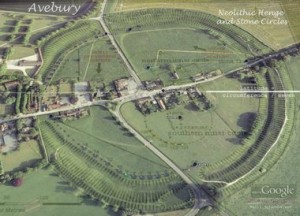Up until we talked about it in class, I had never known that Stonehenge was part of a larger ritual landscape. I thought it was a stand alone structure. I was shocked to learn that there were other smaller versions of henges or that people were buried in and around Stonehenge. I had never really known what the purpose of Stonehenge was or how it came to be. I thought it was fascinating that it was more of a “Land of the Dead” than I realized.
One thing of the structures that stood out to me was the Avebury Henge. In researching it more, I found a few things surprising about it. First of all, it’s much larger than I had originally realized – consisting of three stone circles and reaches 460 yards across. It is also surrounded by a ditch and embankment, just like Stonehenge. Just in the outer circle of the henge were 98 sarsen stones, with many more making up the inner two rings. Similar to Stonehenge, it is believed that the stones were chosen for their acoustic properties for any sound within the innermost ring echoes throughout. Leading up to the monument as well is an avenue marked with more standing stones.
Now the question of what was the Avebury Henge made for is, of course, prominent. There are many theories on the reason for its existence, though the true meaning for it has not been, and probably never will be, discovered. One popular view is that is was used for rituals of the local people, in particular to stave off bad weather, disease, and famine. Another theory is that the rings represent the axis mundi or the center of the world. Another theory centers on the stones themselves, which were not dressed in any way, but take the form of either tall and thin or short and wide. Researchers have theorized that the tall stones were picked to represent men and the shorter stones to represent women.

I agree! Previous to our meeting in class, I had no idea Stonehenge was comprised of more than just stones. Embarrassingly enough, I didn’t even know it was positioned in circles. We rarely see Stonehenge from aerial view- I always envisioned the site to be that of stones…standing up right in random positions. Stonehenge, along with other monumental archaeological sites, have never been a classroom priority for my teachers in grade school. I realized that I always knew what Stonehenge looked like, but not what it stood for, what its story was, or the mystery behind it. It was astonishing to find out that archaeologists were still unclear the purpose behind Stonehenge. Learning about the actual measurements and size of the site was one thing, however learning about the theories revolving the site was another. I like the theory that you mentioned, the one the mentioned Stonehenge as a place to stave off bad weather, disease, and famine. This was an interesting blog to read!
Your blog was a very interesting read. Personally, I had no idea that the Stonehenge and other monuments around it (including barrows) were ancient burial grounds. I was particularly fascinated by the number of theories on the Avebury Henge that have been suggested over the years. Like you mentioned, it is believed that this monument was used for rituals and sacrificial offerings. Some items found at the site include: human and animal bones, nuts, twigs from fruit trees, broken pots, flints and knives which may have played a part in appeasing the gods to ensure good crop yields and fertility. The banked ditch around the Stone Henge is believed to have served as an elevated viewpoint for the people to gather and observe the ceremonies at the henge.
Also, it is believed that the Avebury Henge was a place to “commemorate” the dead. In today’s society, we use stone in graveyards and cemeteries as indicators of those who have passed on. It makes sense that most of the monuments around the Stone Henge are still intact, given that stone is more resistant to erosion compared to other materials that may have been used. Since there are no written records that can clearly state the purpose of the Avebury Henge and other monuments, we may never know their true purpose. However, we can gauge their importance from their elaborate construction and continued preservation. It is interesting to note that pagans and druids revere the Avebury Henge as a place of religious worship and many people today still visit the place to marvel at its existence.